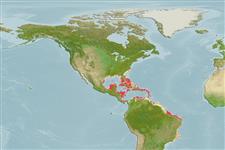Common names from other countries
Teleostei (teleosts) >
Kurtiformes (Nurseryfishes, cardinalfishes.) >
Apogonidae (Cardinalfishes) > Apogoninae
Etymology: Phaeoptyx: Greek, phaios = dark + Gree, ptyx, -ikos = fold (Ref. 45335).
Environment: milieu / climate zone / depth range / distribution range
Ecology
Marine; reef-associated; depth range 0 - 22 m (Ref. 26938). Tropical
Western Central Atlantic: southern Florida (USA) and Bahamas to northern South America.
Size / Weight / Age
Maturity: Lm ? range ? - ? cm
Max length : 9.0 cm SL male/unsexed; (Ref. 26938)
Enlarged melanophores that form large stellate or squarish spots, usually more than 1 per scale below lateral line (Ref. 26938). Vertically elongate blackish blotch at caudal fin base (Ref. 13442).
Commonly found on shallow rocky and coral bottoms (Ref. 9626), in empty conch shells, rubble, or empty containers. Abundant where Acropora palmata abound (Ref. 9626). Oviparous (Ref. 205). Presence of buccal pouch for brooding eggs (Ref. 39366).
Life cycle and mating behavior
Maturities | Reproduction | Spawnings | Egg(s) | Fecundities | Larvae
Are mouthbrooders (Ref. 240, 58878). Spawning may occur throughout the year (Ref. 39366). Distinct pairing during courtship and spawning (Ref. 205).
Robins, C.R. and G.C. Ray, 1986. A field guide to Atlantic coast fishes of North America. Houghton Mifflin Company, Boston, U.S.A. 354 p. (Ref. 7251)
IUCN Red List Status (Ref. 130435)
CITES (Ref. 128078)
Not Evaluated
Threat to humans
Harmless
Human uses
Tools
Special reports
Download XML
Internet sources
Estimates based on models
Preferred temperature (Ref.
115969): 25.4 - 28.2, mean 27.4 (based on 719 cells).
Phylogenetic diversity index (Ref.
82804): PD
50 = 0.6250 [Uniqueness, from 0.5 = low to 2.0 = high].
Bayesian length-weight: a=0.01122 (0.00528 - 0.02384), b=3.10 (2.92 - 3.28), in cm Total Length, based on LWR estimates for this (Sub)family-body shape (Ref.
93245).
Trophic level (Ref.
69278): 3.5 ±0.5 se; based on size and trophs of closest relatives
Resilience (Ref.
120179): High, minimum population doubling time less than 15 months (Preliminary K or Fecundity.).
Fishing Vulnerability (Ref.
59153): Low vulnerability (10 of 100).
